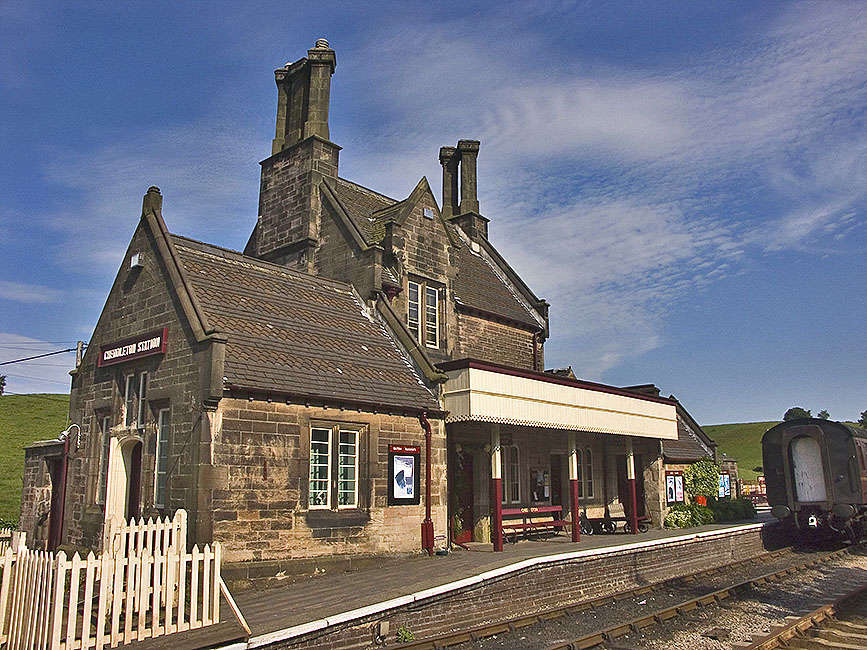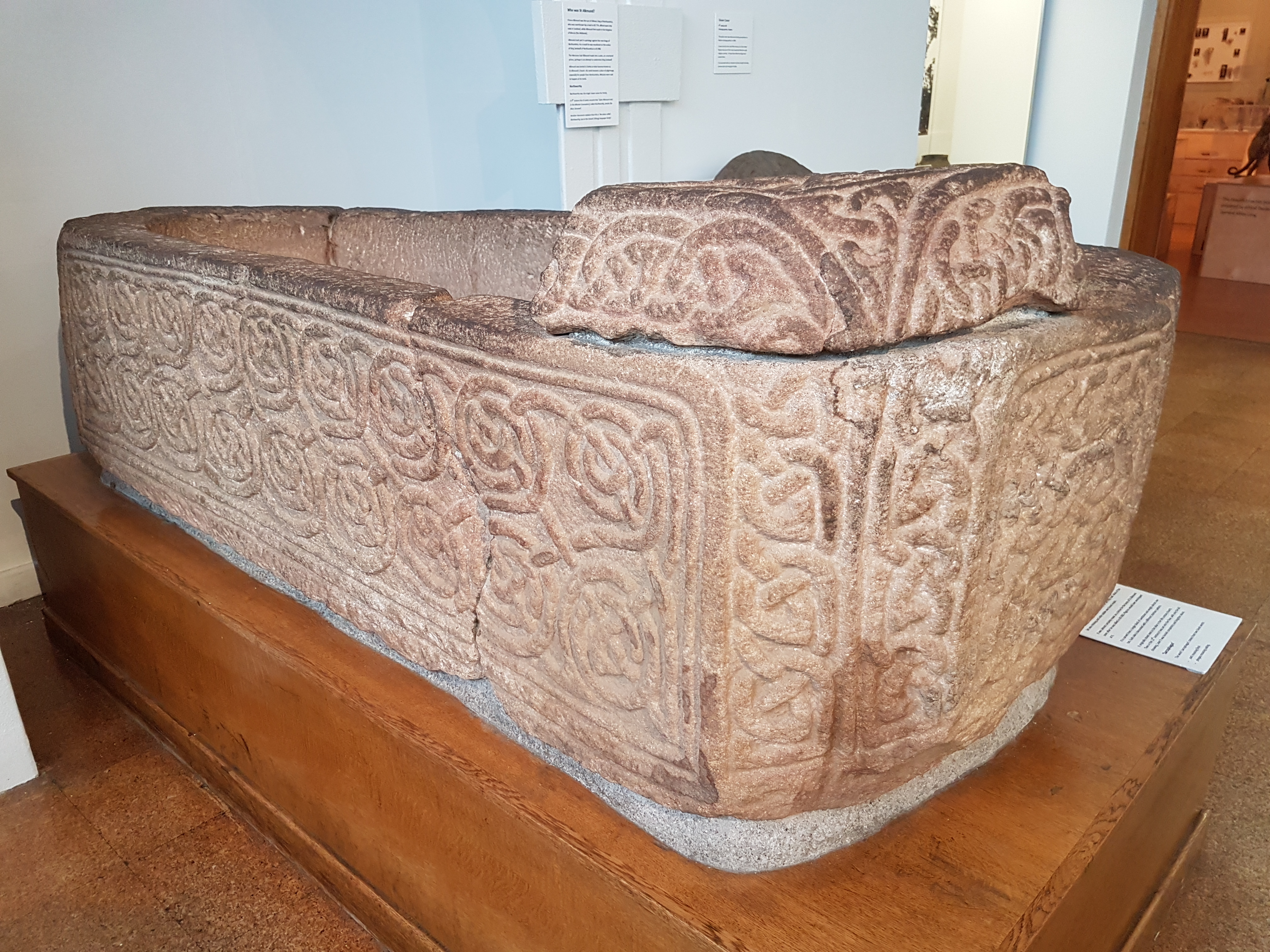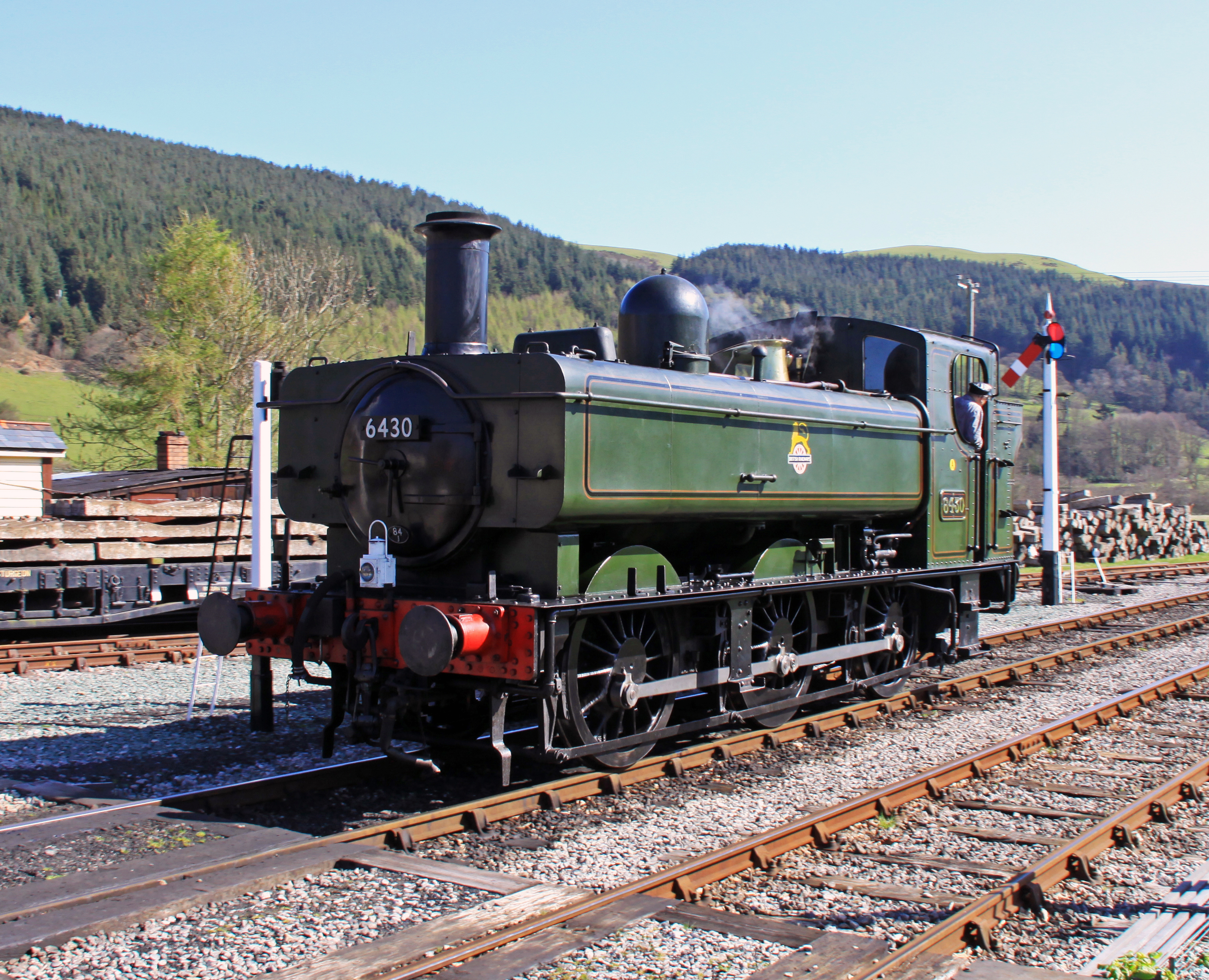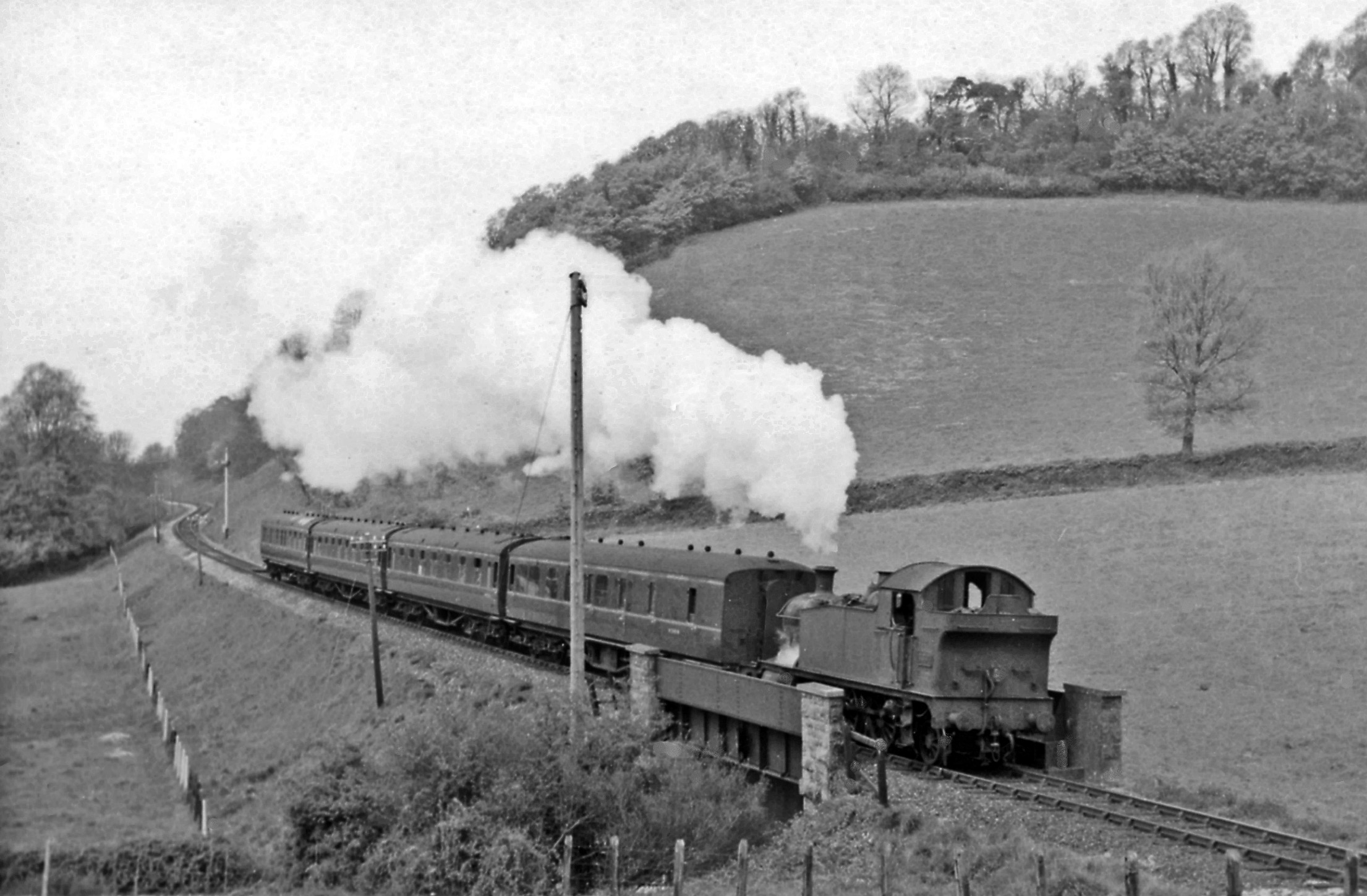|
7821 Ditcheat Manor
Great Western Railway 7800 Class No. 7821 ''Ditcheat Manor'' is a preserved British steam locomotive. The second of the last batch of 10 engines of the thirty-strong class, 7821 was actually built by British Railways in 1950. Like most of the class of lightweight 4-6-0s, it was allocated to lines in Mid Wales, but was also based Oxley and Newton Abbot. 7821 was withdrawn in November 1965 and was sent to Woodham Brothers scrapyard in Barry, Vale of Glamorgan, South Wales. Rescued from Barry in 1980, it was sent to the embryonic Gloucestershire Warwickshire Railway, before moving to the Llangollen Railway and then Swindon, restoration being completed in 1998, when it first steamed at the West Somerset Railway. The loco then worked on the Great Central Railway in Leicestershire, but in late 2005 moved to the Cambrian Railways Trust. 7821 moved again in 2005 to the Churnet Valley Railway where it served its last months of its boiler ticket in traffic. In 2007, the West Somerset ... [...More Info...] [...Related Items...] OR: [Wikipedia] [Google] [Baidu] |
Churnet Valley Railway
The Churnet Valley Railway is a preserved standard gauge heritage railway running through the Staffordshire Moorlands and the valley of the River Churnet in Staffordshire, England. It operates along part of the former Churnet Valley Line, which was opened by the North Staffordshire Railway in 1849, and the Waterhouses branch line which opened in 1905. The section from Kingsley and Froghall railway station, Kingsley and Froghall to Leek (Churnet Valley) railway station, Leek closed to passengers in January 1965 and to freight from Oakamoor railway station, Oakamoor to Stoke-on-Trent railway station, Stoke-on-Trent in 1988; and the Waterhouses branch line, Waterhouses branch closed to passenger traffic in 1935, with the final freight running in 1988. The preservation society began in 1971 with a small demonstration line in the goods yard at Cheddleton railway station, Cheddleton, before beginning operations over the former Churnet Valley Line in 1996 following withdrawal of the f ... [...More Info...] [...Related Items...] OR: [Wikipedia] [Google] [Baidu] |
4-6-0
A 4-6-0 steam locomotive, under the Whyte notation for the classification of steam locomotives by wheel arrangement, has four leading wheels on two axles in a leading bogie and six powered and coupled driving wheels on three axles with the absence of trailing wheels. In the mid-19th century, this wheel arrangement became the second-most-popular configuration for new steam locomotives in the United States, where this type is commonly referred to as a ten-wheeler.White, John H., Jr. (1968). ''A history of the American locomotive; its development: 1830-1880''. New York, NY: Dover Publications. p. 57. As locomotives pulling trains of lightweight all-wood passenger cars from the 1890 to the 1920s, they were exceptionally stable at near speeds on the New York Central's New York-to-Chicago Water Level Route and on the Reading Railroad's line from Camden to Atlantic City, New Jersey. Overview Tender locomotives During the second half of the nineteenth and first half of the twen ... [...More Info...] [...Related Items...] OR: [Wikipedia] [Google] [Baidu] |
West Somerset Railway
The West Somerset Railway (WSR) is a heritage railway line in Somerset, England. The freehold of the line and stations is owned by Somerset Council. The railway is leased to and operated by West Somerset Railway plc (WSR plc), which is supported and minority-owned by the West Somerset Railway Association (WSRA) charitable trust and the West Somerset Railway Heritage Trust (WSRHT). WSR operates services using both heritage steam and diesel trains. It originally opened in 1862 between and . In 1874 it was extended from Watchet to by the Minehead Railway. Although just a single line, improvements were needed in the first half of the twentieth century to accommodate the significant number of tourists that wished to travel to the Somerset coast. The line was closed by British Rail in 1971 and reopened in 1976 as a heritage line. It is the longest standard gauge independent heritage railway in the United Kingdom. Services normally operate over just the between Minehead and . D ... [...More Info...] [...Related Items...] OR: [Wikipedia] [Google] [Baidu] |
Shrewsbury
Shrewsbury ( , ) is a market town and civil parish in Shropshire (district), Shropshire, England. It is sited on the River Severn, northwest of Wolverhampton, west of Telford, southeast of Wrexham and north of Hereford. At the 2021 United Kingdom census, 2021 census, the parish had a population of 76,782. It is the county town of the ceremonial county of Shropshire. Shrewsbury has Anglo-Saxons, Anglo-Saxon roots and institutions whose foundations, dating from that time, represent a cultural continuity possibly going back as far as the 8th century. The centre has a largely undisturbed medieval street plan and over 660 Listed buildings in Shrewsbury, listed buildings, including several examples of timber framing from the 15th and 16th centuries. Shrewsbury Castle, a red sandstone fortification, and Shrewsbury Abbey, were founded in 1074 and 1083 respectively by the Normans, Norman Earl of Shrewsbury, Roger de Montgomery. The town is the birthplace of Charles Darwin. It has ... [...More Info...] [...Related Items...] OR: [Wikipedia] [Google] [Baidu] |
Tyseley
Tyseley is a district in the southern half of the city of Birmingham, England, near the Coventry Road and the districts of Acocks Green, Small Heath and Yardley. It is located near the Grand Union Canal. Etymology Tyseley means "Tyssa's clearing" with "-ley" meaning woodland clearing. Victor Skipp, ''The History of Greater Birmingham - down to 1830'', 1987. Education The local comprehensive secondary school (on Reddings Lane) is Yardleys School, which was newly constructed on the site of a former brick works. The school moved from its previous split site location in 2001. There is also several primary schools located in Tyseley, among those an Islamic school called Al Furqan which was established on site a decade ago. Industry Tyseley was once a thriving industrial area with thousands of people working in the area for major companies such as TI Reynolds (formerly Reynolds Tubes) and Corona, attracting a large number of bicycle and motorcycle manufacturers to the area, and ... [...More Info...] [...Related Items...] OR: [Wikipedia] [Google] [Baidu] |
Oswestry
Oswestry ( ; ) is a market town, civil parish and historic railway town in Shropshire, England, close to the England–Wales border, Welsh border. It is at the junction of the A5 road (Great Britain), A5, A483 road, A483 and A495 road, A495 roads. The town was the administrative headquarters of the Borough of Oswestry until that was abolished in 2009. Oswestry is the third-largest town in Shropshire, following Telford and Shrewsbury. At the 2021 Census, the population was 17,509. The town is from the Welsh border and has a mixed English and Welsh heritage. Oswestry is the largest settlement within the Oswestry Uplands, a designated Natural areas of England, natural area and national character area. Toponym The name ''Oswestry'' is first attested in 1191, as . This Middle English name transparently derives from the Old English personal name and the word ('tree'). Thus the name seems once to have meant 'tree of a man called Ōswald'.A. D. Mills, ''A Dictionary of English Pl ... [...More Info...] [...Related Items...] OR: [Wikipedia] [Google] [Baidu] |
GWR 7800 Class 7819 Hinton Manor
7819 Hinton Manor is a Great Western Railway locomotive part of the Manor Class. It is one of 9 locomotives preserved from the class which originally had 30. Service 7819 was built by the Great Western Railway in 1939 and was initially allocated to Carmarthen before moving to Oswestry in 1943. It regularly worked the Cambrian Coast Expresses in the 1960s until being withdrawn from service in November 1965 and moved to Woodham Brothers scrapyard in Barry, Vale of Glamorgan, South Wales.SVR Charitable Trust 7819 page (Retrieved 30 November 2017) Preservation 7819 was acquired from Barry in 1973 by the Hinton Manor Fund with help from the Severn Valley Railway Company. Followin ...[...More Info...] [...Related Items...] OR: [Wikipedia] [Google] [Baidu] |
Swindon Designer Outlet
Swindon Designer Outlet is a covered designer outlet in Swindon, England. The outlet occupies most of the restored Great Western railway works and is owned by McArthurGlen. Built by Tarmac Construction and opened in March 1997, it is a few miles from junction 16 of the M4 motorway. In the eating area, a number of steam locomotives that were built at Swindon Works Swindon Works was opened by the Great Western Railway in 1843 in Swindon, Wiltshire, England. It served as the principal west England maintenance centre until closed in 1986. History In 1835, Parliament approved the construction of the Great ... have been on display: * 3440 ''City of Truro'' from March 1997 until May 1999 * 4930 ''Hagley Hall'' from May 1999 until June 2007 * 7819 ''Hinton Manor'' from June 2007 until August 2018 * 7821 ''Ditcheat Manor'' since August 2018 References External links * Buildings and structures in Swindon Outlet malls in England Shopping centres in Wiltshire Shoppin ... [...More Info...] [...Related Items...] OR: [Wikipedia] [Google] [Baidu] |
Museum Of The Great Western Railway
STEAM – Museum of the Great Western Railway, also known as Swindon Steam Railway Museum, is housed in part of the former railway works in Swindon, England – Wiltshire's 'railway town'. The museum opened in 2000. The site The museum is housed in a former engineering workshop, built c.1842 using squared rubble from the Box Tunnel, and forming part of the Swindon Works of the Great Western Railway. The works was one of the largest in the world and operated from 1843 to 1986. In its heyday, it covered more than , and could turn out three locomotives per week. Most of the former works buildings are now a McArthurGlen Designer Outlet. Also on the site are the headquarters of the National Trust (in the Heelis building) and offices of English Heritage. The museum Apart from many exhibits of interest to railway engine and rolling stock enthusiasts, it tells the social story of the railway community in Swindon, with recorded personal experiences and film archives. Lifelike exh ... [...More Info...] [...Related Items...] OR: [Wikipedia] [Google] [Baidu] |
South Devon Railway (heritage Railway)
The South Devon Railway (SDR) is a heritage railway from Totnes to Buckfastleigh in Devon. Mostly running alongside the River Dart, it was initially known as the Dart Valley Railway. The railway is now operated by the South Devon Railway Trust, a charitable organisation, registered charity. The railway's headquarters and museum are located at Buckfastleigh railway station. History A railway between Newton Abbot and Ashburton, Devon, Ashburton received Parliamentary approval and Royal Assent in 1848. However, with the economy in recession the scheme failed to find sufficient backing. After the Parliamentary approval of construction of the South Devon Railway Company (SDR) from Exeter to Plymouth, a new Buckfastleigh, Totnes and South Devon Railway scheme was proposed to make a junction with the SDR at Totnes and link it with Buckfastleigh, running alongside the River Dart. It opened as a broad gauge line through to on 1 May 1872 and was operated from the outset by the SDR (whi ... [...More Info...] [...Related Items...] OR: [Wikipedia] [Google] [Baidu] |
GWR 6400 Class
The Great Western Railway (GWR) 6400 Class is a class of 0-6-0 pannier tank steam locomotive introduced by Charles Collett in 1932. All 40 examples were 'auto-fitted' – equipped with the remote-control equipment needed for working GWR Autotrain, autotrains. The 1936 GWR 7400 Class was a similar class, without the autotrain apparatus, but with a higher boiler pressure of 180 psi, providing a small but useful increase in power. An initial build of 30 in 1936-1937 was added to by British Railways in two batches each of ten locos in 1948 and 1950. These were destined for a short life, the briefest being only nine years. A minor visual difference between the 5400 and earlier 6400, and the later series of 6400, with the 7400 classes was at the join between cab and bunker. The 5400 and early 6400 had an arc whereas the later 6400 and the 7400 class was straight. The early locos also had a lip at the leading edge of the cab roof, whereas the later locos had a plain corner edge. Both ... [...More Info...] [...Related Items...] OR: [Wikipedia] [Google] [Baidu] |
West Somerset Railway Association
The West Somerset Railway (WSR) is a heritage railway line in Somerset, England. The freehold of the line and stations is owned by Somerset Council. The railway is leased to and operated by West Somerset Railway plc (WSR plc), which is supported and minority-owned by the West Somerset Railway Association (WSRA) charitable trust and the West Somerset Railway Heritage Trust (WSRHT). WSR operates services using both heritage steam and diesel trains. It originally opened in 1862 between and . In 1874 it was extended from Watchet to by the Minehead Railway. Although just a single line, improvements were needed in the first half of the twentieth century to accommodate the significant number of tourists that wished to travel to the Somerset coast. The line was closed by British Rail in 1971 and reopened in 1976 as a heritage line. It is the longest standard gauge independent heritage railway in the United Kingdom. Services normally operate over just the between Minehead and . Dur ... [...More Info...] [...Related Items...] OR: [Wikipedia] [Google] [Baidu] |






